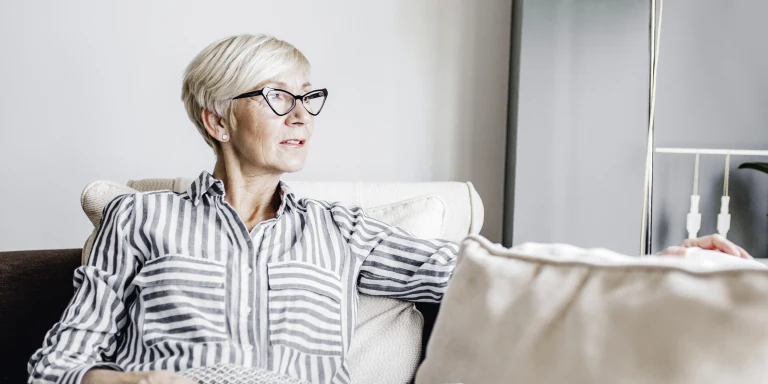Glaucoma – insidious damage to the optic nerve
Glaucoma is a collective term for various eye diseases involving irreparable damage to the optic nerve. Without treatment, sufferers are at risk of going blind. In many cases, the disease is linked to increased inner eye pressure.

What is glaucoma?
Glaucoma is a collective term for eye diseases involving progressive destruction of the optic nerve. This results in visual defects that are also referred to as blind spots. Once the damage has occurred, it is irreversible. Treatment should therefore begin as soon as possible. If sufferers go untreated, they are at risk of going blind.
What are the different types of glaucoma?
On the one hand, a distinction is drawn between primary and secondary glaucoma: primary glaucoma is an isolated disease of the eye, whereas secondary glaucoma occurs as a consequence of another disease, a medical intervention or an injury, or as a side effect of medication. On the other hand, cases of glaucoma can also be divided into open-angle glaucoma and angle-closure glaucoma depending on the nature of their “chamber angle”.
What causes glaucoma?
In many cases, the disease is linked to increased inner eye pressure. This occurs when the drainage of aqueous humour at the “chamber angle” is disrupted. Among other things, the aqueous humour supplies the lens and the cornea with nutrients. Normally, more aqueous humour is formed at the same rate as it drains away. If it cannot drain away or if too much is produced, the inner eye pressure increases. This compresses the optic nerve more and more tightly, causing irreparable nerve damage.
However, glaucoma can also occur at normal inner eye pressure. The causes of this normal-tension glaucoma are still unknown. It is thought that it may be caused by circulation problems affecting the optic nerve and the retina.
Lastly, some children enter the world already suffering from glaucoma. This is because the drainage of the aqueous humour has not developed correctly.
Who does glaucoma affect?
In principle, glaucoma can occur in anyone, but the likelihood of developing the disease increases with age. The disease generally affects people aged 40 or over. In Switzerland, glaucoma is one of the main causes of blindness in people over 60.
The disease is more likely to develop in people with:
- increased inner eye pressure;
- cases of glaucoma in the family;
- increased short-sightedness of more than -5 dioptres;
- long-sightedness;
- cardiovascular diseases;
- prolonged treatment with cortisone;
- African or Asian origins.
What are the symptoms of glaucoma?
The treacherous thing about glaucoma is that it causes no symptoms at first. People often only realise they have the disease when eye damage has already occurred. By that stage, however, the damage can no longer be reversed.
Glaucoma can produce the following symptoms:
- red eyes (this can also have many other causes, such as dry eyes);
- headaches and eye pain;
- coloured rings around light sources;
- black spots/black areas (blind spots).
Black spots are the most serious symptom and are formed when certain optic nerve fibres are damaged, generally due to high inner eye pressure, and can therefore no longer relay visual signals to the brain. This results in what are known as blind spots. Immediate and consistent treatment of glaucoma is essential because the damage will otherwise continue to advance and there is a risk of tunnel vision or, in the worst case, complete blindness.
A special case is the type of glaucoma known as a glaucoma attack, in which the drainage channel for the aqueous humour suddenly becomes blocked. This causes a sharp increase in the inner eye pressure within the space of a few hours. Among other things, typical symptoms include a palpably hard eyeball, a red eye, eye pain and headaches, visual defects, nausea, vomiting and a mid-dilated pupil that is unresponsive or barely responsive to light. A glaucoma attack is a medical emergency that requires immediate medical attention.
If a newborn baby suffers from glaucoma, this often manifests as large eyes that water easily and are sensitive to light. The eyelids are also tight.
How is glaucoma treated?
Treatment options vary depending on the variety and stage of glaucoma, the disease progression and the tolerability and efficiency of medications.
Medicinal therapy
The initial treatment for glaucoma is generally eye drops, which are intended to bring down the increased inner eye pressure.
Laser treatment
If medicinal therapy of glaucoma is unsuccessful, laser treatment may be considered. The aim of this is to improve the drainage of the aqueous humour or to reduce its production.
Glaucoma surgery
If neither medicinal therapy nor laser treatment is successful in cases of glaucoma, a surgical procedure can be carried out to reduce the inner eye pressure. This surgery can be performed using various techniques. Depending on the method and on the patient’s age and state of health, the procedure may be carried out on an outpatient or inpatient basis and under either local or general anaesthetic. There is, however, a risk that the newly created outflow for the aqueous humour will become obstructed or blocked completely due to scarring. Regular medical follow-up checks are therefore important in the first three months after glaucoma surgery.
Who covers the costs of glaucoma treatment?
In principle, the cost of medication such as eye drops is covered by your basic insurance. Ask your therapist about the cost implications prior to treatment. If the plan is to drain the aqueous humour via an artificial channel using “stents”, it is vital to check whether the costs are covered by the basic insurance in each individual case. PRIMEO supplementary insurance covers the use of a special femtosecond laser.
Do you have questions?
We're here to help.